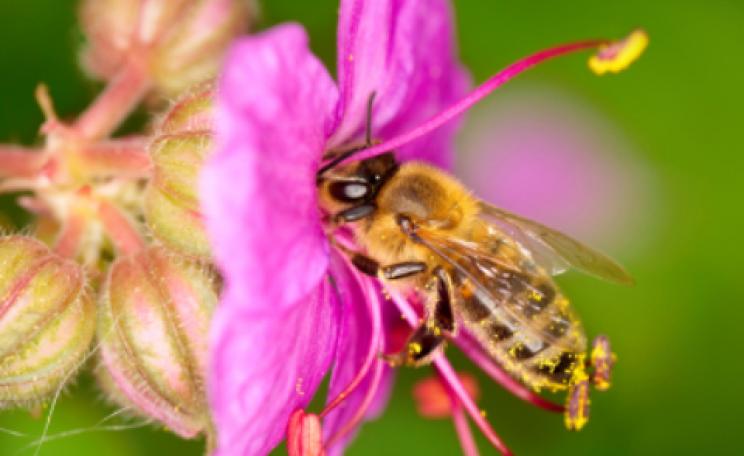Beekeeping for development
Annoyed with the marginalisation of the beekeeper’s role in genuine sustainable development, Nicola Bradbear and Helen Jackson founded Bees for Development in 1993 – an organisation devoted to promoting global understanding of the benefits of beekeeping. Ten years on, Bradbear and Jackson’s project remains central to spreading awareness of beekeeping’s potential to improve livelihoods and ecological sustainability at a grassroots level.
‘Small-scale [beekeeping] projects do not tend to attract government or donor support… [so] beekeeping [is] ignored,’ explains Bradbear.
Since it spans forestry, horticulture, agriculture, natural environment, animal husbandry and entomology, beekeeping cannot be easily classified into a single sector of development aid. Consequently, apiaries have not been well-endorsed by aid projects in the past. Even worse, bees are commonly treated as pests and are often blasted with insecticide in the summer.
Minimal input needed
Beekeeping equipment does not need high-tech materials and can be easily made from natural resources already used locally. People are experimenting with baskets to make hives in Gambia, while other more traditional methods use clay in Bangladesh, bark in Zambia and cow dung and ash in Ethiopia. And protective clothing can be put together cheaply from old sacks.
When they are not reliant on external manufacturers, beekeepers can replace equipment without extra expenditure – no matter how small their profits are. And as bees can live almost anywhere, people with no land can rely on bees feeding off wild plants and still harvest the honey. What’s more bee colonies are attracted by empty hives, so keepers rarely need to spend money on buying their bees.
Extra source of income
Beekeeping is low-maintenance. Bees do not need to be fed, and honey only has to be collected once or twice a year – in early and possibly late summer. So, little time is needed to generate money from keeping hives.
Secondary products (which generally produce far better returns than straight honey) of beekeeping can be made locally and range from soap and lip balm for export in the Philippines, to candles for local churches in Ethiopia and honey beer in Tanzania. Organic honey still generates a large proportion of the income in Zambia.
Prioritises the environment
As Helen Jackson says: ‘Bees are central to biodiversity.’ They pollinate flowering plants that provide other herbivores with food. In 2000, for example, a massive tree-planting scheme in Cape Verde relied on bee pollination for its success. This then encouraged more bee colonies to inhabit the forests and different species of fauna were in turn able to thrive there.
There is an economic incentive for beekeepers to protect their local environment. Pesticides and fertilisers poison bees and hence reduce the income from honey for keepers. In 1997 France lost 70 per cent of its honey harvest when insecticide-treated sunflower nectar poisoned honeybees. Farmers who keep bees are less likely to use harmful chemicals.
All the family is involved
The whole family can both participate in and benefit from the maintenance of apiaries. Apiculture is of symbolic importance in many societies. Beekeeping is frequently almost exclusively a male occupation, but the materials beekeeping yields are often used by women in the manufacture of secondary products. And older community members often play a vital part in educating younger generations in the beekeeping arts. In Mali there is a belief that only old men are able to ward off any negative supernatural effects on beekeeping.
BEE NUMBERS
150 million years in which bees have been producing honey
45,000 bees can live in a single hive
30,000 number of bee species
11,400 strokes of a bee's wing per minute
80 percentage of insect crop pollination performed by honeybees
66 pounds of pollen accumulated per hive per year
25-40 percentage rise in crop productivity resulting from bee pollination
12 bee colonies needed to pollinate one acre of cotton
1 the size in mm3 of a worker honeybee's brain
Truly sustainable development..
Working for beekeeping development world-wide, helping people to the use the craft of beekeeping to improve their standards of living, in ways that are sustainable and environmentally beneficial. A tiny, non for profit organisation that is making a real difference to hundreds of small communities. For more information contact Bees for Development, Troy, Monmouth, NP5 4AB, UK. Telephone: 01600 713648 or visit the website www.planbee.org.uk
BEE FACTS
• Bees produce the only food that will never spoil. Honey found in Egyptian tombs is still edible.
• Honeybees fly backwards out of their homes so they can see how they look from a distance.
• Honey has been used to embalm bodies (Alexander the Great being a notable example) as decay-promoting microbes cannot live in it.
• The hexagonal compartments that make up the structure of honeycombs are mathematically proven to be the most efficient means of storage possible. An absolute minimum of material is used to create hives.
• Honeybees have a dance ‘language’ that alerts other bees where nectar and pollen are located. The circle and waggling dance explains direction and distance. Bees also communicate with pheromones.
• Once the male drones have fulfilled their summertime role of mating with the queen, they are expelled from the hive because they are of no further use.
• Bees use the sun as a compass. Even when it is obscured by clouds, bees can detect its position from the light in brighter patches of the sky.
• Both the Egyptians and the Welsh have at some time used honey to pay taxes.
• The giant Indian bee (Apis dorsata) builds a single comb as much as five feet by three feet big, and which is attached to rocks, trees or buildings.
• In Ghana a good honey harvest is said to be related to beekeepers’ relationships with invisible hairy dwarves. In Sweden failure in apiaries is blamed on the influence of trolls.
This article first appeared in the Ecologist May 2003



